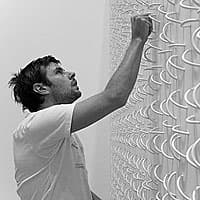Jonathan JONES

Throughout my practice, I have been interested in developing work that explores relationships—relationships between community and the individual, personal and public, object and environment, historical and contemporary. To represent these complex yet simple lived ideas, I work with everyday materials such as electrical cabling, household light bulbs, tarpaulin, thread and paper in a language that appears simple in execution yet conveys their complexity. The play of light and shadow are intended to compel a sense of personal immersion in the works as the light emanates lines and shadows, drawing not only on rich Kamilaroi and Wiradjuri cultural line work but also on current socio-political concerns. On the other hand, the construction and placement of the works draw on Aboriginal architecture and use of space.
Jonathan Jones is an installation artist whose work involves the use of electric lights. He conceptually and literally illuminates issues relating to identity, race, family, community, Country and cross-cultural histories.
Jones’s interest in the use of electric light began soon after the passing of a very close aunty during his first year at art school. He created a work featuring 56 coolamons to represent his aunty’s age at the time of her death, with 18 of them lit to represent his own age at the time. The 18 lit coolamons kept the memories alive and the work overall kept the connections together. Quite minimalist in form, Jones’s works are informed by his Aboriginal heritage and by his family, both of which have had a major influence on him:
… the subject central to my practice is the symbiotic relationship of community to the individual, and individual to the community. The two are inseparable … My light installations provide a contemporary urban Indigenous perspective on … ethnopolitical notions, and act as a platform for understanding the operations of the community and the individual, in the interests of a national community.[1]
Jones’s lean to 2012—similar to his earlier lean-to 2007 although on a larger scale—has been built specifically for unDisclosed.[2] It is based on the notion of the Aboriginal use of space.It references the form of an Aboriginal humpy, or lean-to (a type of housing), through the ingenious use of deceptively simple household items. Humpies are found in many Aboriginal communities and are often made from combinations of scrap material such as forked branches, corrugated iron, metal posts and plastic sheets to provide shelter from the elements. Jones’s lean to incorporates the form and function of these community structures but instead comprises MDF board, blue tarpaulin and electric fluorescent tube lights in a way that brings together these Aboriginal references.
Jones’s lean to features three large freestanding walls and three works on paper. The walls sit diagonally or at an angle to the gallery walls, appearing as though they have just fallen, leaning precariously against one another. Within each wall, on one side, cool white fluorescent lights form broken lines in a magnified chevron or zigzag design. The pattern formed by the lights is similar to traditional Aboriginal designs found on dendroglyphs (carved ceremonial trees), shields, clubs, spear-throwers and possum-skin cloaks from south-eastern Australia. Large, blue tarpaulins cover the lit side of each panel, forming a barrier that softly diffuses the lights behind and creating an overall surreal environment in which visitors are immersed in a vibrant blue with lines of white to capture their attention. The blue saturates the space and envelops the visitors as they enter and move through the space and around the walls. It seeps into the cracks and gaps and out through the entrance, not only connecting the installation with the other rooms but also enticing and drawing in visitors. The blueness distorts one’s sense of self as it changes vision and appearance as well as changing the shadows.
The strong, bold white lines of the fluorescent tubes, seemingly suspended in midair, contrast with the semi-transparent tarpaulin and highlight its minuscule flaws—its creases, folds and imperfections. This adds to the texture and immediacy of the work and provides depth and variation. Similar bold lines can be seen in Emily Kam Kngwarray’s Yam Dreaming paintings, John Mawurndjul’s rarrk designs, and the fine line drawings of nineteenth-century artist Tommy McRae.
Jones’s minimalist approach skilfully illuminates the sometimes hidden interconnected histories of Aboriginal and non-Aboriginal people. The sense of immersion in the work tantalises viewers’ senses and provides a focal point to their lives and histories, illuminating imaginings and memories.
Tina Baum
[1]Jonathan Jones, Jonathan Jones, exhibition brochure, Gallery Barry Keldoulis, Sydney, 2003, p .
[2] Another of Jones’s light-works revolution 2010 will represent the artist’s recent work when unDisclosed tours nationally, as lean to 2012 is too large to travel.

